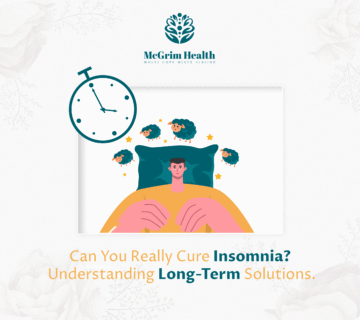Lewy Body Dementia (LBD) is a brain disorder that keeps changing. It affects how you think, move, and feel. The diagnosis of LBD follows Alzheimer’s disease as the second most recognized dementia condition.
However, what are the first signs of Lewy Body Dementia?
It is important to find it early. The initial symptoms, the causes, the stages, and the possible treatments for Lewy Body Dementia will be discussed below.
In case you are suffering from dementia, McGrim Health will always be your support. McGrim Health offers personal dementia care. We shape our care to your necessities, making your life better. Go to our website to learn more about the treatments that will enhance your life quality.
Understanding Lewy Body Dementia
Lewy body dementia remains the second most common form of the disease, but it is the one that is caused by the brain. This is a disorder that affects about 1.4 million people in the United States.
The reason for the disorder is alpha-synucleine proteins whose amounts called Lewy bodies are way more than normal levels and they appear in the brain.
These protein lumps cause the brain to not work as it should which obstructs cognitive and movement disorders.
LBD appears in both Alzheimer’s and Parkinson’s disease. It also shows up in people without these diseases. This makes diagnosis difficult.
Is Parkinson’s Disease a Form of Dementia?
This disease is not mental deterioration, but it can change into Parkinson’s disorder dementia later on. So, they are related. It mostly causes movement issues.
Some patients also have trouble thinking clearly. The signs are specific to dementia with Lewy bodies (DLB). They relate to Parkinson’s and arise on their own.
Parkinson’s patients might not frequently show signs of mental decline, yet the risk intensifies as the condition worsens.
Parkinson’s Disease vs. Lewy Body Dementia
Parkinson’s disease (PD) and LBD are brain disorders. They are similar in various ways but differ greatly:
- Parkinson’s disease manifests itself with movement issues such as trembling, rigidity, and slowed movements. Cognitive difficulties and eventual memory loss may follow.
- Lewy Body Dementia (LBD) usually comes with various problems in thinking and memory early on, along with sleep disturbances and hallucinations that cause difficulties in everyday activities. Even though a person might have movement troubles, they tend to be less severe than the ones someone with Parkinson’s experiences.
Both diseases slowly but effectively spread until medical treatments were out to manage the symptoms.
What Are the First Signs of Lewy Body Dementia?
Diagnosing Lewy Body Dementia is hard at first. The symptoms are similar and vary. Early signs include:
-
Visual Hallucinations
One of the major initial problems of LBD is having vivid hallucinations-vision of things that are not there. The hallucinations, which last long and are repetitive, generally include forms of animals or people.
-
Cognitive Fluctuations
The feeling of being unpredictable in cognitive activities, the ability to concentrate, and alertness may be affected. They may be fully integrated and communicative for one minute, but then the next moment becomes foggy or unresponsive.
-
Movement Difficulties
LBD might induce symptoms comparable to Parkinson’s disease, including slow mobility and balance issues, leading to frequent spills.
Sleep Disturbances
Rapid Eye Movement (REM) sleep issue syndrome commonly influences those with LBD. It encourages them to live out their hopes. It can disrupt their sleep and result in injuries.
-
Behavioral and Mood Changes
In the early stages, a person may feel depressed, anxious, or paranoid. They might also show unusual behavioral changes. Sometimes, violence in dementia patients can occur due to confusion or frustration.
Lewy Body Dementia Stages
Each type of LBD has its progression through the stages and carries symptoms that are different from one another:
- Early stage: This is where the person may face mild cognitive and movement problems
- Middle stage: Increased hallucinations, movement difficulties, and memory loss
- Late stage: Severe dementia, inability to move, and loss of speech
Alzheimer’s and Dizziness: How It Relates to LBD
Dizziness is common in people with Alzheimer’s and Lewy Body Dementia. It often comes from problems with the autonomic nervous system.
It can lead to irregular blood pressure and poor balance. As a result, frequent falls become a big concern in both conditions.
Dizziness is a frequent symptom of Lewy Body Dementia, and it is often accompanied by orthostatic hypotension. The latter is described by the sudden blood pressure drop while standing. The deposits of Lewy bodies disturb the autonomic nervous system, thus provoking this problem.
To treat giddiness in dementia patients, they should be constantly monitored for hydration, sudden movements should be avoided, and medications that may affect stability should be regulated.
Why Do Some Alzheimer’s Patients Experience Tremors?
A common question is, what causes tremors in Alzheimer’s patients? While Alzheimer’s mainly affects memory and cognition, tremors could still occur in patients as a result of the damage to other essential neurological elements.
Tremors can be more frequently met with Lewy Body Syndrome and Parkinson’s disease however, they might also emerge in Alzheimer’s patients who have motor complications.
Medications and Treatment Options for Lewy Body Dementia (LBD)
LBD is incurable, but some interventions can support patients in managing symptoms.
-
Medications
Acetylcholinesterase inhibitors help with cognitive symptoms. Other medications may treat mood or sleep issues.
-
Physical Therapy
Physical activity can also improve motion, equilibrium, and force in the form. Exercise can reduce the risk of falling and keep the body healthy.
-
Better Sleep Habits
The REM sleep disorder and sleep regularity could be some of the sleep problems that could be treated. Good sleep hygiene and treating sleep problems can be as effective in increasing rest and safety.
-
Support Groups
The availability of support groups is a golden opportunity for those with LBD and their caregivers. These groups provide emotional and mental support and real-life guidelines that will help you master your daily life.
Final Thoughts
So, what are the first signs of Lewy Body Dementia? The first signs of Lewy Body involve similar signs to other conditions. A comprehensive medical examination is the key to the proper evaluation of the first signs of Lewy Body Dementia.
As education and recognition prevent the speedy progression of Dementia, which will benefit the patient and their family members.
LBD signs include delusions, unsteadiness, sleep problems, and memory decline. See a doctor right away.
FAQs
Can Lewy Body Dementia be slowed down?
Drugs can relieve symptoms, but there’s no fix.
Does sympathetic increase heart rate in dementia patients?
Yes, autonomic dysfunction in LBD can cause irregular heart rate and blood pressure changes.





No comment